All the colours of the rainbow: 8 bizarre Australian slugs

AUSTRALIA IS HOME to some of the most bizarre-looking slugs on Earth. And this gets exponentially weirder when you consider that Australia has only two families of native, land-dwelling slug – Cystopeltidae (humpback slugs) and Athoracophoridae (red-triangle slugs).
Introduced land slug species can be found across Australia in backyards, usually among veggie gardens. Yet our terrestrial natives are confined to the eastern parts of Australia because they prefer wet forest, says Queensland Museum’s Dr John Stanisic, who goes by the nickname ‘the snail whisperer’.
However, our most colourful, charismatic slugs live in the ocean waters surrounding Australia. These are nudibranchs, which are so striking they’ve inspired their very own sea slug census, for which underwater photographers compete to capture the best images of these beguiling beauties.
But John remains passionate about the terrestrial ones. His favourites are the red-triangle slugs, because of their bright colouring – which varies according to location. He’s particularly fond of the pink-to-red form found on Mount Kaputar, in northern NSW, and the all-orange form found on Mount Bellenden, in Queensland.
That many of these slugs have particular habitat requirements means they often find themselves in what are considered Endangered Ecological Communities. An example is the pink Mount Kaputar slug, which is listed as endangered.
Here, we look at some of the most interesting species of Aussie slug, both on land and underwater.
1. Mount Kaputar slug
Triboniophorus aff. graeffei
These bright pink-to-red slugs that sometimes grow up to 20cm long, only live on Mount Kaputar in northern NSW, camouflaged among beds of fallen red eucalyptus leaves.
They live among 20 other species of land snails in the same area as part of an Endangered Ecological Community.
The identification and listing of this land snail community under the NSW Threatened Species Conservation Act (1995) is the first of its kind in Australia.
According to geologists, a volcanic eruption 17 million years ago on Mount Kaputar kept a small, 10sq.km area lush and wet, perfect for the slugs and other unique species.
The Mount Kaputar is a red-triangle slug, but an ongoing revision of the group could prove that it’s a separate species
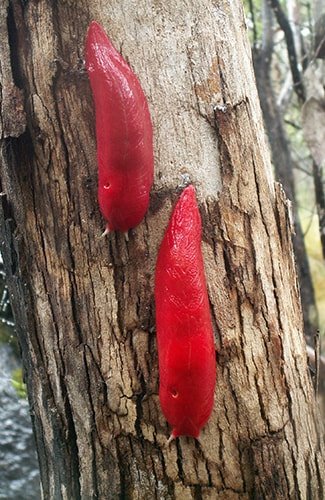
(Image credit: Michael Murphy)
2. Leopard slug
Limax maximus
The leopard slug is an introduced species well-adapted to urban Aussie life, often feasting on dead animal tissue, cat food and pet poo, according to the Australian Museum.
The slug gets its common name from its spotty, leopard-like body, but it also goes by the name ‘great grey slug’ due to being one of the largest slugs in the family Limacidae.
As if things couldn’t get weirder, their mating behaviour is rather unique. According to John, two slugs ascend a tree where one will secrete a mucus string. The partner then slithers down the string, at the end of which mating takes place.
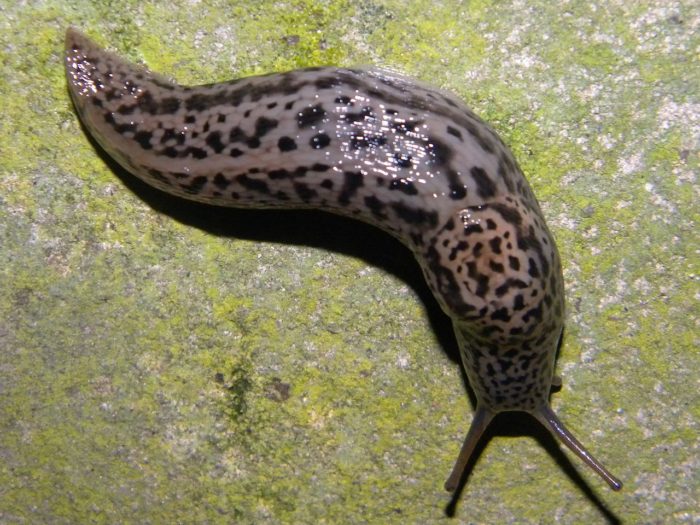
(Image credit: Max0rz /Wikimedia)
3. Elysia sea slug
Elysia chlorotica
Ever heard of a solar-powered mollusc? Well, photosynthesis plays a big part in the life cycle of the Elysia sea slug.
These tiny, green molluscs are able to steal chloroplasts from their algal food source. Chloroplasts are parts of plant cells that capture energy from sunlight, and these slugs use them to capture energy in much the same way – a rare ability in animals.
Whether the formation of the Elysia species has been driven more by geographic isolation of populations or through ‘ecological speciation, where different groups of animals start to use different resources in the environment, has been subject to debate.
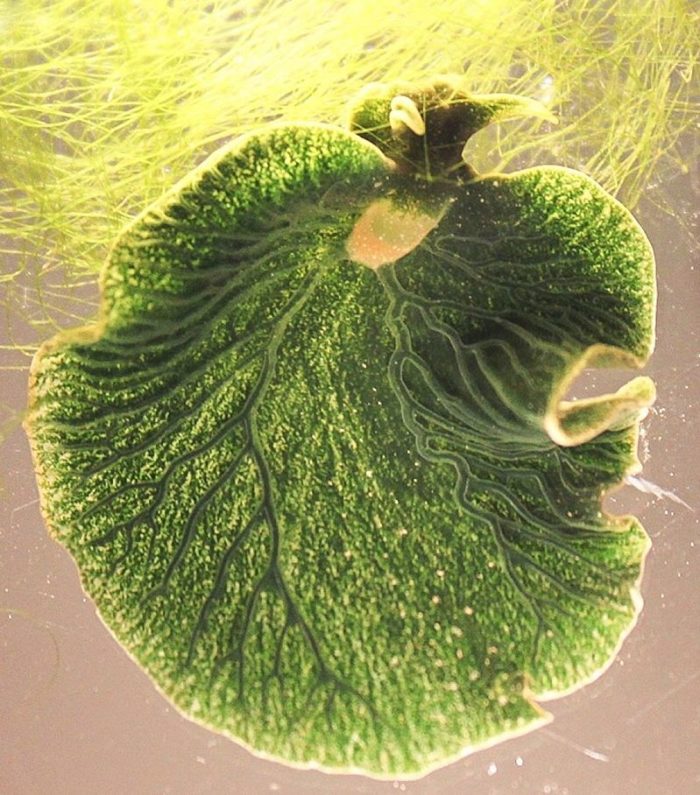
(Image credit: PNAS)
4. Nudibranchs
It’s hard to choose just one species of nudibranch to focus on, given the wide-range of colours, shapes and sizes they sport; not to mention, there are more than 3000 species worldwide, with 700 in Australian waters.
Nudibranchs can be easily spotted around rocks and coral. Although these molluscs may seem vulnerable without a hard shell, the bright, patterned skin of some species protects them by warning predators of their toxicity and foul taste, while other species are highly camouflaged.
`Nudibranch’ comes from the Latin word for ‘naked gill’, and refers to their frilly exposed gills. Some have finger-like ‘cerata’ on their backs, rather than a plume of gills, and they are nearly blind, relying on scent and touch via a pair of horn-like rhinophores on their heads.
Like their land-living slug cousins, they are hermaphrodites, with the reproductive organs of both sexes. They can lay up to 1 million eggs, which hatch into larvae. Very few survive, but some will grow to surprise divers with their wonderful colours.
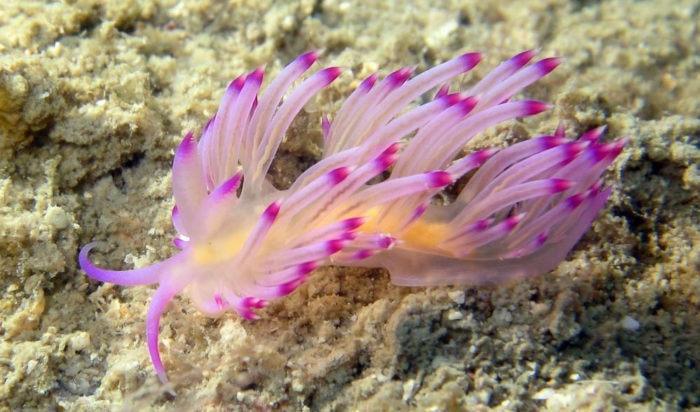
Flabellina Rubrolineata. (Image credit: Chaloklum Diving)
5. The blue dragon
Glaucus atlanticus
It may seem bright and beguiling once washed up onto a local beach, but when it’s in the water the blue dragon is a master of disguise, using its colours to blend with ocean and sky.
Unlike other species of nudibranch that live on the seafloor, blue dragons will swallow a little air bubble, which allows them to float on the ocean surface but means they’re at the mercy of the weather and predators.
To avoid predation, blue dragons feast on the stinging cells of bluebottles and transfer these to the tips of their cerata or ‘wing’, which gives them the ability to sting. The bright blue camouflage of these nudibranchs is another way the animal avoids predation. The technique is known as ‘countershading’ which describes how the blue dragon is darker on its upper side and light on its underside.
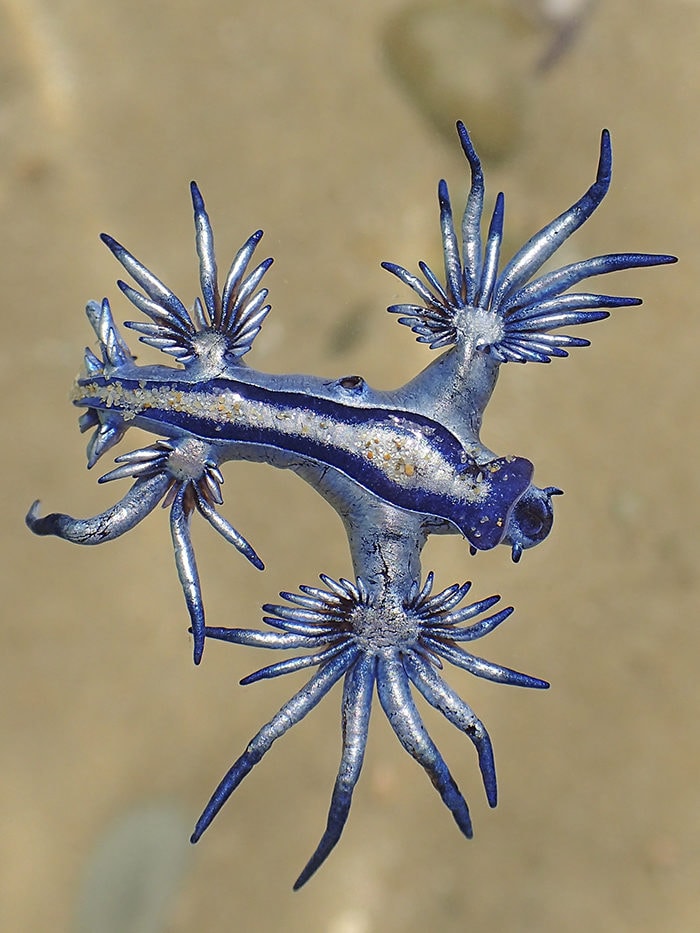
(Image Credit: Steve Smith)
6. Pacific Ocean-dwelling sea slug
Siphopteron quadrispinosum
These brightly coloured slugs are found on Australia’s Great Barrier Reef as well as in the waters around New Guinea and Hawaii. They have forked penises, roughly the length of their bodies.
Like the leopard slug, these sea slugs have a bizarre mating ritual. During 40-minute mating sessions, the slugs reciprocally push one branch of the penis into each other’s female genital opening and release sperm, while the other branch penetrates their partner’s head, very close to the eye.
Here they use a sharp spike to inject a chemical secretion from the slug version of a prostate gland. This may have an effect on the central nervous system, which increases the chance of a successful fertilisation for the slug injecting the secretion.
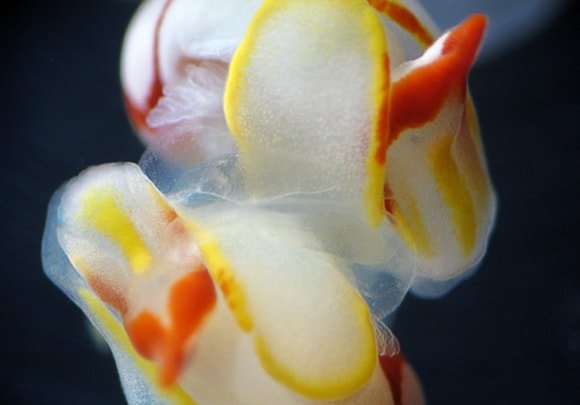
Intercourse between Great Barrier Reef sea slugs. (Image credit: Dr Rolanda Lange)
7. Red triangle slugs
Triboniophorus graeffei
These unique-looking slugs get their name from the tiny red triangle usually contrasted against a creamy white background that decorates their bodies. However, sometimes, the red-triangle slug sports a yellow, orange, red or pale green coat.
These slugs include the giant pink-to-red slugs of Mount Kaputar and live in lush, wet forests. The Mt Kaputar slugs are one of number of unique snail species marooned 1500m above sea level on an extinct volcano near the township of Narrabri.
Many red triangle slugs can also be found in urban areas. Their slimy, circular trails have been known to decorate fences and spotted gums. Unlike pest species that feast on a homeowner’s beloved veggie garden, the red-triangle slug prefers microscopic algae and fungus.
Scientists are trying to determine whether or not the different colours represent different species.
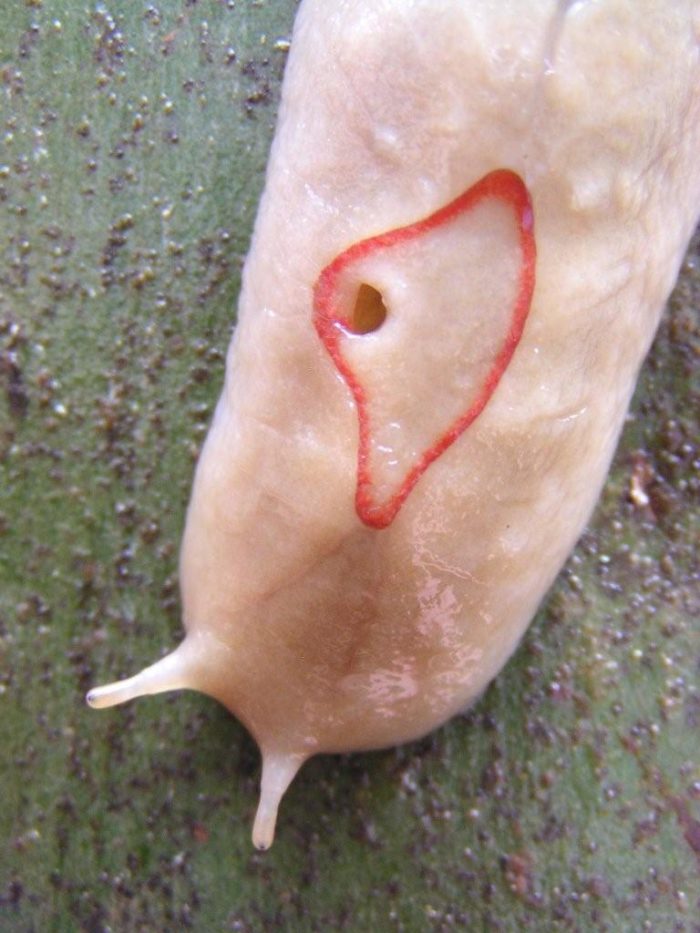
(Image credit: Ros Runciman)
8. Southern semi slugs
Helicarion spp.
Semi slugs have one of the most bizarre features ever seen on a slug. They represent the “intermediate stages in the evolutionary process,” according to the Australian Museum. Basically, they have a shell – like a snail – but it’s too small for the slug to fit into, so it just kind of sits, ear-shaped, on their back.
Semi slugs from the genus Helicarion are particularly beautiful, with their glassy-green and shiny yellow shells. They’re restricted to Tasmania and parts of lower NSW. Recently, it was discovered that only two species belong to this genus. Previously, there was thought to be four. And their preferred habitats vary from high altitude mountain tops to dry forest.
In 2017, a newly discovered species was named in honour of legendary nature documentary-maker Sir David Attenborough, Attenborougharion rubicundus. The striking slug is spattered with bright pink colour, with a bulbous green shell sitting on top.




